Golf and Country Clubs
First task. Impress the readers.
Risk management is a Sisyphean challenge.
First task accomplished? Probably not yet.
Let me continue.
In Greek mythology, Sisyphus was a deceitful king who was condemned to spend eternity pushing a giant boulder up a mountain. As Sisyphus approached the peak of the mountain, the rock would elude him and roll back down to the bottom. Interminable activities are often called Sisyphean tasks or challenges. (Thanks Wikipedia for making me sound smarter than I truly am.)
First task accomplished? Still not yet, but hopefully, I have earned your attention.
Golf club operations are sophisticated ventures. Golf courses and country clubs cover a sprawling amount of real estate, with numerous mini-businesses (recreational facility with food service, retail sales, customer service, property rental and other entrepreneurial enterprises) making up the whole.
The members of the golf course management team are multi-talented, master jugglers. They move about the facility putting out fires. The hope is that they can get to “the problem” before it gets to them. With that being the case, how much time and energy does a golf course manager, professional or superintendent have available for the Sisyphean challenge of identifying and managing risk?
That is where “you” come in.
Insurance companies can help golf courses bring some measure of control to the task of managing risk. Sophisticated risk management departments provide golf club insureds with invaluable advice and technical guidance.
Insurance agents are the face of the insurance process. By establishing a
personal/professional relationship with clients, you can influence decision-making and behavior. Insurance agents can play an integral role in helping golf courses iden-tify, assess and address risk on the golf course.
Following is a strategy you might be able to use the next time you meet with existing or potential customers.
Just as I endeavored to gain your attention, you must succeed at gaining their attention. Scare them. I hate to resort to scare tactics, but when it comes to safety and liability, sometimes you have no choice. The most effective method of gaining the attention of a golf course is through hard facts that speak for themselves.
Step 1: Get the golf course’s attention
Step 2: Help the golf course prioritize its risks
How do your insureds make sense out of those random facts? Fortunately, insurance companies are good at turning isolated incidences and raw data into meaningful and useful statistics. The St. Paul Travelers insurance company recently completed a study of more than 21,000 property and general liability claims filed over an 18-year-period. The St. Paul Travelers, through its Eagle 3 insurance program, insures more golf courses than any other carrier. Both size of loss and frequency are important. Following are two tables demonstrating claims experience from more than 1,400 golf courses.
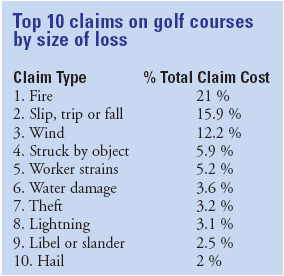
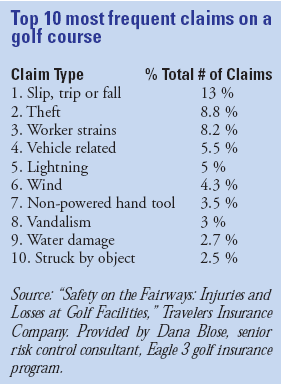
Based on the Eagle 3 claims information, you can help golf courses prioritize their risk management efforts. Golf clubs only have a limited amount of time, money and effort to commit to eliminating, reducing and managing risk. They will appreciate any principled direction they can get. Claims information is concrete evidence, and a strong indication of where a golf club should commit its resources.
Step 3: Put it in terms they understand
The Eagle 3 claims information is organized in terms of general liability, property and a little bit of workers’ compensation. You know this stuff, your customer does not. You will be on their turf. Speak in their terms as best you can.
You don’t have to have all the answers. That’s what the experts are for.
Provide your golf club clients with a valuable service by issue-spotting. Look for potentially dangerous areas or operations. Make sure they have the proper coverage in place. But also educate your client regarding potential risk management techniques.
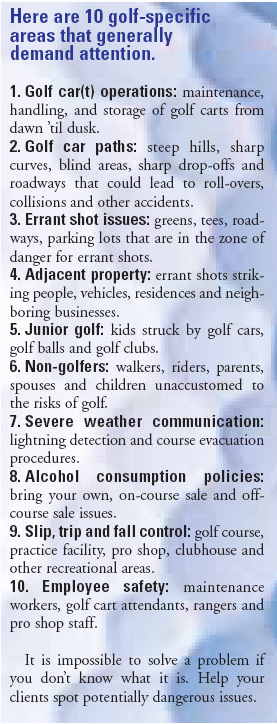
Step 4: Express confidence that risk is manageable
Golf courses need to make a commitment to safety — in attitude and atmosphere. To prevent devastating injuries and fatalities, golf clubs need to change behavior and eliminate dangerous circumstances. In classic risk management theory, those confronted with risk can eliminate, reduce, transfer, insure or retain the risk. Support your golf course’s risk management efforts.
Fewer accidents means fewer claims, fewer claims means an agent, insurer and insured will be pleased with the outcome. With a little forethought and some time, money and effort, golf courses can handle the Sisyphean challenge of managing risk.
Step 5: Get the experts involved
If golf club operators are truly interested in managing risk, they will welcome any and all advice on the subject. Whether it is because of self interest or altruism, get those golf club owners, managers, professionals and superintendents connected to risk management experts at insurance companies and consulting firms. That is where they can find the most qualified advice on risk assessment and management.
Agents are trusted, frontline personnel who have a great impact on customer decision-making and behavior. Use your unique position to champion risk management principles. Once you have their attention, help the golf club prioritize and understand the risks in its industry. Offer your experience and knowledge of risk to whet the appetite of the golf course owner, manager, professional and superintendent. The experts in the field of risk management will take it the rest of the way.
For those current and potential customers who are simply paying “lip service” to the concept of risk management, be patient. Risk management is tough stuff, especially in today’s golf market where time, money and energy is stretched thin. Don’t give up on those golf clubs. You never know when the light bulb will go on, and your efforts will be acknowledged and rewarded. Consistently beat the drum and offer regular assistance from risk management experts.
Back to mythology
You say, give me some more Greek mythology to wrap this thing up.
I say, how about Hercules?
The challenge of managing risk is a constant battle — a day to day grind full of daunting tasks. In Greek mythology terms, risk is a many-headed serpent. Think Hydra. When Hercules chopped off one head, two more would appear. Eventually, Hercules killed Hydra, but he did not do it alone. He needed the skill and guile of his nephew to slay the serpent. (Thanks again Wikipedia.)
Is comparing risk to a condemned king and mythological sea creature too far-fetched? Perhaps, but statistics, jury verdicts, tragic accidents and claims information tell us otherwise. Addressing risk is a constant battle. As soon as one problem goes away, another is there to replace it. Golf courses can conquer the Sisyphean challenge of solving Hydra-like problems … with your help.
Mike Kraker is an attorney based in St. Paul, Minn. He represents and consults with golf clubs, golf course architects and other members of the golf course industry. He has spoken and written on behalf of the St. Paul Travelers golf course risk management program and has provided expert witness testimony in legal cases involving errant golf shots. He can be reached at 651-292-8001 or michael@golflawyer.com. Kraker also operates www.golfcourseforms.com.
Topics Claims Risk Management Human Resources
Was this article valuable?
Here are more articles you may enjoy.


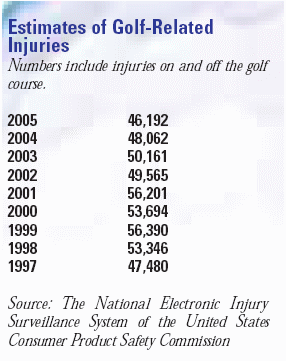
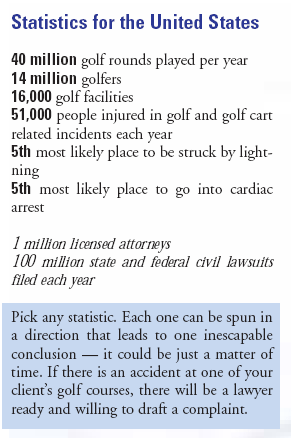
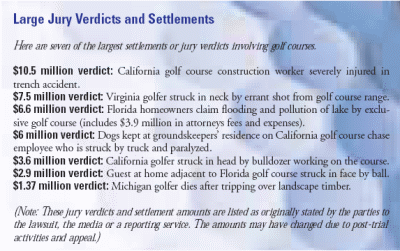
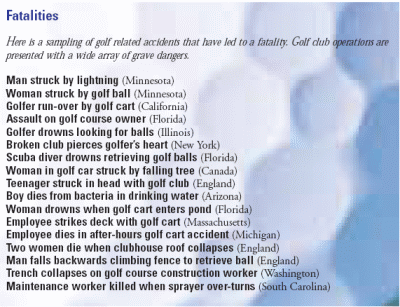
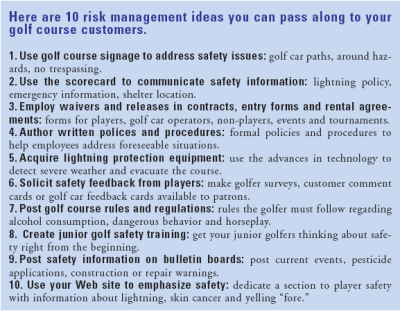
 As Rates Rise, Majority of Homeowners Say Insurance Industry Is in Crisis: Survey
As Rates Rise, Majority of Homeowners Say Insurance Industry Is in Crisis: Survey  Home Insurance at $10,000 a Year Shows California Buyers’ Pain
Home Insurance at $10,000 a Year Shows California Buyers’ Pain  US P/C Insurers Post Best Q1 Underwriting Result In 17 Years
US P/C Insurers Post Best Q1 Underwriting Result In 17 Years  Farmers Adjusters Cry Foul Over Workloads, Claims Handling in Letter to Regulators
Farmers Adjusters Cry Foul Over Workloads, Claims Handling in Letter to Regulators 


